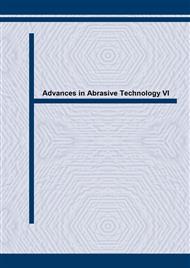[1]
F. Klocke: Dry Cutting, Annals of the CIRP, Vol. 46 (1997), p.519.
Google Scholar
[2]
F. Klocke et al: Coated Tools for Metal Cutting-Features and Applications, Annals of the CIRP, Vol. 48 (1999), p.515.
DOI: 10.1016/s0007-8506(07)63231-4
Google Scholar
[3]
U. Heisel et al: Application of Minimum Quantity Cooling Lubrication Technology in Cutting Processes, Production Engineering, Vol. II (1994), p.49.
Google Scholar
[4]
T. Wakabayashi et al: Turning using Extremely Small Amount of Cutting Fluids, JSME International Journal, Series C, Vol. 41 (1998), p.143.
Google Scholar
[5]
J.W. Sutherland et al: An Experimental Investigation of Air Quality in Wet and Dry Turning, Annals of the CIRP, Vol. 49 (2000), p.61.
DOI: 10.1016/s0007-8506(07)62896-0
Google Scholar
[6]
S. Suda et al: Evaluation of Machinability with MQL System and Effectiveness in Production Lines, Proceedings of the International Tribology Conference, 2000, p.203.
Google Scholar
[7]
J. McCabe and M.A. Ostaraff: Performance Experience with Near-Dry Machining of Aluminum, Lubr. Eng., Vol. 57 (2001), p.22.
Google Scholar
[8]
S. Suda et al: A Synthetic Ester as an Optimal Cutting Fluid for Minimal Quantity Lubrication Machining, Annals of the CIRP, Vol. 51 (2002), p.95.
DOI: 10.1016/s0007-8506(07)61474-7
Google Scholar
[9]
S. Mori et al: Chemisorption of Organic Compounds on a Clean Aluminum Surface Prepared by Cutting under High Vacuum, ASLE Transactions, Vol. 25 (1982), p.261. 0 5 10 15 20 25 30 35 40 45 50 0 5 10 15 20 Cutting Time [sec] Cutting Force [N]Ft Fc 0 5 10 15 20 25 30 35 40 45 50 0 5 10 15 20 Cutting Time [sec] Cutting Force [N]Ft Fc Fig.9 Results of cutting force measurement in different atmosphere (a) oxgen + ester (b) oxgen
DOI: 10.1080/05698198208983089
Google Scholar


